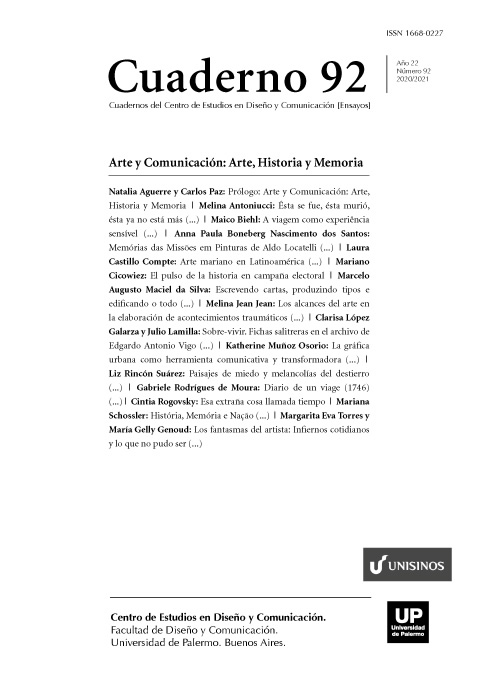Arte mariano en Latinoamérica: La iconografía religiosa como mecanismo de control y sello de identidad durante la Conquista
Abstract
From antique times, art has been used to communicate both beliefs and aesthetic values of societies and as a mechanism of control of the ruling class. This article aims to analyze the Marian Art in Latin America during the first decades after the Castile Crown conquest, the symbolic struggle that took place over that “Conquest of the imaginary” period and the emergence of a proper identity expression through triangle-shaped mestizo virgins such as Virgen del Cerro de Potosí, the Inmaculada Concepción and Virgen de Luján. During the first years of the conquest, the faithful, far from leaving their old cults behind, added the new Marian miracles situated in hills (previous places of pre-Columbian worship to Pachamama), leading a syncretism among religions. The old virgins were not fully imposed but adapted by using domestic manufacture and indigenous features. As a result, a Marian art would arise as a reflection of a new stage in the continent with new meanings and mestizo iconographies following negotiations and cultural tensions. In pursuit of the miraculous virgins favor, pilgrimages have become the trigger of local economies and have consolidated the power of the church until today.
References
Beozzo, J. O. (1984). “A mulher indigena e a Igreja na situaçao escravista do Brasil colonial”. En VV. AA, A mulher pobre na história da Igreja latino-americana, Sao Paulo. pp. 70-93.
Bonfil Batalla, G. (1972). “El concepto de indio en América: una categoría de la situación colonial”. Revista del Instituto de Investigaciones Antropológicas, Universidad Nacional Autónoma de México (UNAM), Vol 9.
Capoche, L. (1959 [1585]). Relación General del Asiento y Villa Imperial de Potosí y de las Cosas más Importantes a su Gobierno. Biblioteca dDaniel, s.II d.C., 31 y ss. De Tello, A. Crónica Miscelánea de Jalino. Citado en VARGAS UGARTE, O. c., p. 14.
Eichmann, A. (2007). “La Virgen-Cerro de Potosí: ¿Arte mestizo o expresión emblemática?”, Revista de Historia Americana y Argentina, Nº 42. Mendoza (Argentina), U. N. de Cuyo, ISSN: 0556-5960, pp. 33-53.
Foster, G. M. (1962). Cultura y conquista, Universidad Veracruzana, Xapala. Gisbert, T. “El Cerro de Potosí y el dios Pachacámac”, Vol 42, Nº 1, Revista de Antropología Chilena, pp. 169- 180.
Guérault, J. A. (1961). La virgen de Luján y su santuario. Síntesis histórica. Evocaciones. 90 páginas (1a. edición). Buenos Aires. Editorial Baraga.
Gombrich, E. H. (1960). Art and Illusion. Pinceton University Press.
Hernández González, S. (2012). Devociones marianas de gloria y órdenes religiosas en Andalucía. SIMPOSIUM (XXª Edición), San Lorenzo del Escorial, 6/9 de Septiembre de 2012, pp. 107-120.
__________. (1991). “Leyes de Burgos de 1512 y Leyes de Valladolid de 1513”. Publicado en Fundación para el desarrollo provincial. Burgos, p 21.
Lorandi, A. M. (2002). Ni ley, ni rey, ni hombre virtuoso. Guerra y sociedad en el virreinato del Perú. Siglos XVI y XVII, Barcelona: Gedisa.
Male, E. (2012). El arte religioso de la Contrarreforma. Madrid: Encuentro. Paredes Laos, J. (2015). La revelación de las imágenes. Disponible en: https://elcomercio.pe/eldominical/actualidad/revelacion-imagenes-390250
Pasztory, E. (2015). Thinking with things, Towards a New Visions of Art. University of Texas Press, Austin. Parte 2.
Ramos, G. (1976). Lib. II, cap XVIII.
Salinas, M. L. (2009). “Trabajo, tributo, encomiendas y pueblos de indios en el nordeste argentino. Siglos XVI-XIX”, Revista Iberoamericana, IX, 34, pp 21- 42. San Agustín. Enarrationes in Psalmis, 101, 1.
Sebastián, S. (1981). Contrarreforma y barroco. Madrid: Alianza Editorial.
Stratton, S. (1988). La Inmaculada Concepción en el arte español. Madrid: Fundación Universitaria Española. e Autores Españoles, Madrid.
Los autores/as que publiquen en esta revista ceden los derechos de autor y de publicación a "Cuadernos del Centro de Estudios de Diseño y Comunicación", Aceptando el registro de su trabajo bajo una licencia de atribución de Creative Commons, que permite a terceros utilizar lo publicado siempre que de el crédito pertinente a los autores y a esta revista.


